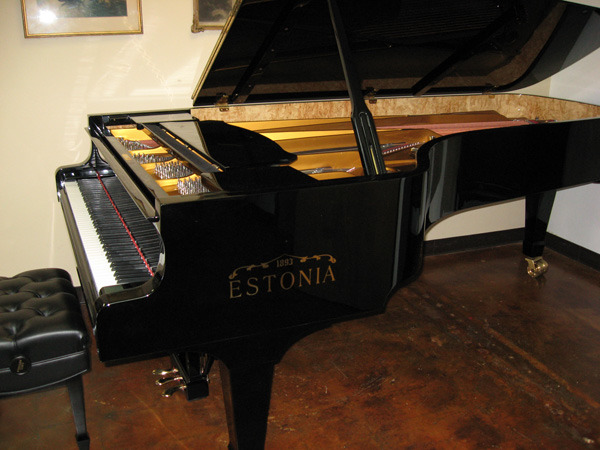Two of the most iconic keyboard instruments in the history of music are the piano and the harpsichord.

Pleyel Revival Harpsichord, 1930s (Photo by Christopher D. Lewis)
Of course, at first glance, they share important similarities. They look alike: both have keyboards, both come in a case and have soundboards, and both are played by a seated player. Sometimes, their repertoire even overlaps. There are works originally written for harpsichord that today are played almost exclusively on the piano.

A grand piano
But in the end, the piano and the harpsichord work in fundamentally different ways. There are several reasons why one became the instrument of the future, while the other hit its peak of popularity in the 1700s.
Today, we’re exploring the intertwined histories of the piano and the harpsichord, how they each create sound, the types of music written for both…and why the piano ultimately won the battle for supremacy.
Harpsichord vs modern piano
Historical Origins
The first surviving harpsichords date from the 1520s. These early instruments had small tones, making them ideal for accompanying singers or string players, as opposed to bold solo virtuoso statements.
World’s Oldest Playable Harpsichord
On the other hand, the first surviving pianos date from the 1720s, and were built by a harpsichord maker named Bartolomeo Cristofori. Cristofori named his new instrument “un cimbalo di cipresso di piano e forte” (or, translated from Italian, “a keyboard of cypress with soft and loud”). Eventually, that name was shortened to pianoforte and eventually just “piano.”
Hear the World’s Oldest Piano at The Met Museum
Sound Production
The fundamental difference between the piano and the harpsichord lies in the mechanisms that each uses to create sound.
The harpsichord uses a plucking mechanism to create sound when a key is pressed, whereas the piano employs an action and hammers to strike the strings.
As you can imagine, a string that is hammered sounds very different from a string that is plucked. This vital distinction gives each instrument a distinctive sonic character.
Dynamic Range
Because of this difference, the piano holds an important advantage over the harpsichord: its ability to produce a wide dynamic range.
Since players can control how hard the note is hammered, they can have precise control over the volume and intensity of the sound.
By contrast, the harpsichord has a limited dynamic range, since the plucked strings produce a relatively consistent volume, regardless of the weight of the player’s touch.
Articulation and Expression
With that extensive dynamic range, the piano offers an entire palette of aural color for musicians to employ and enjoy. Those palettes only expanded during the nineteenth and twentieth centuries as technology advanced. During that time, concert halls grew in size, public performances became more frequent, and composers’ and pianists’ creative and technical visions helped to push the boundaries of what the piano was capable of.
Yuja Wang – Carmen Variations (Bizet Horowitz)
But the harpsichord, with its limited dynamic capabilities, relies on the use of ornamentation, such as trills and mordents, to enhance expressiveness. (Of course this isn’t a bad thing, by any means! It’s just different from what a piano does.) But this more subtle method of expression went out of favor in the days of extravagant virtuosity and flashy Romanticism.
Jean Rondeau records Rameau’s Les Sauvages
Versatility and Repertoire
In the end, the piano’s dynamic versatility allowed it to become a staple instrument in a variety of genres, from classical compositions to jazz, pop, and beyond. Today its vast repertoire encompasses centuries of musical works.
Meanwhile, given that the height of its popularity was in the eighteenth century, the harpsichord is primarily associated with Baroque music.
That said, some modern players and composers are still attracted to the harpsichord’s unique sound. Even twentieth century composers like Poulenc, de Falla, Glass, and others wrote new work for the instrument. Not to mention, thought-provoking modern recordings of Baroque works have changed how pianists approach their own performances of the same repertoire. So it’s not like harpsichords ever became totally obsolete.
Manuel de Falla Concerto for Harpsichord, Flute, Oboe, Clarinet, Violin and Cello
Nevertheless, by the time the nineteenth century was over, there was a clear winner in the popularity battle between the piano and harpsichord.
Conclusion
Both the piano and the harpsichord hold a special place in the history of keyboard instruments. But in the end, the piano was the keyboard instrument that brought music into the future.
The piano simply offered more than the harpsichord ever could: more dynamics, more tools for expression, more technical innovation, and more versatility. And that’s the reason why, in the long battle of pianos versus harpsichords, the piano eventually emerged as the winner.
For more of the best in classical music, sign up for our E-Newsletter

Loved the article. Thanks Emily! It was a nice trip back to remembering music university/highschool